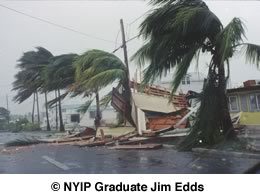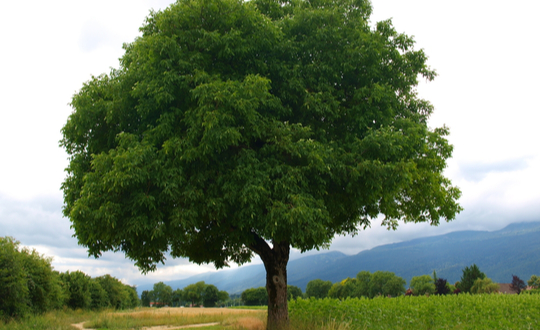
Editor's Note: I’ve been following Jim’s career ever since the day, probably 10 or 12 years ago, when he came up and introduced himself to me when our paths crossed at New York’s PhotoPlusExpo. At that time, he had just graduated from NYIP and was concentrating on two kinds of photography — underwater work and interiors. Now based in Pensacola, at that time Jim was working out of the Florida Keys, not a bad place for underwater work.
Jim had recognized me on the show floor from the NYIP video programs, so he just came up to say hello. That’s the kind of guy he is, direct, outgoing, and ready to enjoy every opportunity. Some years ago, Jim decided his future was on land, and he became a professional storm chaser. As his career takes him to new places (and, it seems to me, ever more dangerous situations) he checks in from time to time.
Whenever I get an e-mail from Jim I expect an interesting picture or story. For example, his DVD of Hurricane Ike was picked up by WalMart for distribution and Jim sent me a photo of the hefty five-figure check they sent him.
However, when I opened his e-mail, I wasn’t prepared for this tornado photograph — the beautiful way that the sky is covered with shades of black and gray in an animated state is almost reminiscent of a William Blake etching. The lighter tones in the sky as the eye comes down the rope-like shape of the tornado to the ground provide a dramatic and clear background to the photo. I’d never seen anything quite like it.
When Jim kindly consented to let us use this photograph, I sent him an e-mail with some questions about how the photo was made. Here, with a few edits, are Jim’s answers.
Q. Did this tornado do any damage?
There wasn't any damage from this tornado — it happened in an open area in Goshen County, in the south east part of Wyoming.
Q. How did you come upon it? Advance notice or just lucky?
I've been trying to hunt down a tornado for the last four years. I'd go out to Tornado Alley for two weeks at a time and follow these tornado-producing supercells which are thunderstorms on steroids. Ideally you get right under a cloud that shoots up to 50-60,000 feet and the whole thing rotates. You follow it until it drops a tornado. I saw the supercell on my laptop that is configured to receive high resolution Doppler radar. Storm photographers use the cell phone networks to download Internet data and keep up with all the storms that are firing around you. I was way over in Sterling, Colorado when this supercell was “tagged” by the National Weather Service as a “severe thunderstorm”. A yellow box comes up around it on the radar display.
Since this was the best-looking storm on radar I decided to head for it. I was way out of position near Sterling, Colorado at the time and I need to get to Southeast Wyoming. I plugged in the position on my GPS and it plotted an intercept route for me. About an hour or so later it went to "Tornado Warned" which means either a tornado is on the ground or the radar has picked up rotation in the sky. A red box came up around the storm on my radar display now.
I felt for sure this supercell would produce a tornado and I was too far out to capture it. My luck had not been too good with tornadoes. About 35 miles out I could see the wall cloud — the section where a tornado will drop. At 30 miles out I finally had a good road option that took me due west — straight for the tornado. The only thing that could mess up the intercept was the huge hail and rain just north of the wall cloud. I could see it on radar just north of the road I was on. Get into that hail and it’s all over — it can bust out the windows and total your vehicle. After turning west I saw it — a huge fat tornado just below the wall cloud. I turned on the dash cam to record the drive up. I was still too far away for any good still pictures though. I was just hoping it would still be there when I came within range.
After about 25 minutes of driving, the group I was with split up to find good shooting spots. I picked a lonely road free of any obstructions like telephone poles and wires. I first set up my video cam on the tripod then reached for my still camera in the back of the SUV that was already configured to shoot a tornado.
Q. What camera did you use for this photo and how did you make exposure decisions?
I used a Canon 5D full frame with 70-300 IS lens set at 150mm. The picture was taken in Shutter Priority at 1/500 of a second. Aperture was f/8, and the ISO was 400. I used evaluative metering, the camera's standard metering mode. I took the photo in RAW.
I already had the ISO and shutter speed set, because I knew I wouldn't have much time to fiddle with the controls. Sometimes a tornado will last only seconds so I had to be really fast. I had great light to the side and back that really lit up the tornado.
At first I shot some stills of it when it was a straight fat tornado. Then it thinned out some. As it thinned out and weakened it gets pushed around by rain-cooled air and started to enter what we call the "rope out" phase. The rope out state lasted about 50 seconds and you had to be ready with your finger on the shutter to catch it. I selected the 1/500th shutter speed to stop any debris that might be swirling around the funnel.
The tornado started to bend all over the place as it went up into the sky. I remember making sure I zoomed out enough to capture the entire length of it plus some land too. There were just a few seconds where it really looked good. I saw a lot of photos of this tornado from other photographers at different locations, but they had wires or poles covering up part of the tornado or it just didn’t have that same dramatic look in the sky. I picked a good spot, no doubt, but sometimes in this business you get lucky. I got a fantastic look and was there ready to capture it.
Q. How long was it there?
About five minutes total, after I stopped my car. The rope out phase lasted about 50 seconds, and less than ten seconds where it looked really good.
Q. Did you find this more anxiety-provoking than your usual storm coverage?
Yes, because I'd been trying to capture a tornado for 4 years.
Q. And finally, did you have the motor running in your car?
Yes, the golden rule is never turn off the ignition when you pull over to film a tornado. Believe it or not, my friend Jeff Piotrowski stopped to film a tornado that was coming right at him. After firing off a few shots, he jumped back in the car, and — you guessed it — it wouldn't start. Jeff had to run to a nearby farmhouse a couple hundred yards away and hide in the cellar with the owner’s family. The tornado went right over the house demolishing it.
Other weather pictures by Jim Edds
In addition to tornado tracking, Jim was kind enough to provide us with a collection of various pictures he's taken on location in pursuit of hurricanes. Below are just a few pictures that show some of the damage caused by fierce winds and torrential rain.




Many photography buffs find that nothing compares to shooting nature. Some think nature is at its most beautiful when deadly. Even if you have training with a photography school, you need to take extreme caution when trying to shoot something as unpredictable and dangerous as a tornado.







